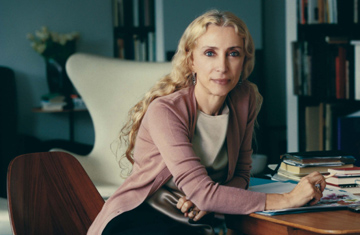
Rebellion has become Franca Sozzani's calling card, helping her transform Vogue Italia into one of the world's most influential fashion magazines
In the aftermath of last year's BP disaster in the Gulf of Mexico, Franca Sozzani did more than ruffle feathers. She drenched them in oil. For the August 2010 issue of Vogue Italia, the audacious fashion editor interpreted the crisis by dousing model Kristen McMenamy in crude. Body splayed on a polluted beach, McMenamy gasped as oil dripped from her Alexander McQueen glove to her Dior fox-fur coat and, clad in Alaïa and Miu Miu, quivered and coughed over 22 more pages. A caption explained that this survivor "keeps her skin golden thanks to Self Tan Face Bronzing Gel Tint."
Critics lambasted Sozzani for glamorizing tragedy and dismissed her as an opportunist. Just over a year later, sitting in her office in Milan, she remains unapologetic — and feels more than a bit misunderstood. Banalities about skin bronzer aside, "the spread had a positive message," she says, petting her sleeping West Highland terrier. "Don't push nature too much, or she will rebel against you."
Rebellion has become Sozzani's calling card. It's helped her transform Vogue Italia from a domestic trade publication into the world's most influential fashion magazine, despite its relatively small circulation of 140,000 (compared with the 1.3 million readership of the more commercial American Vogue). Other editors view it as the barometer of which models and photographers will become household names, and newsrooms warm up the presses whenever Sozzani champions a cause — or takes a misstep. Earlier this month, she suggested that Dior rehire John Galliano after a French court convicted the designer of anti-Semitic speech. And in August she sparked a global race row by running a feature on hoop earrings titled "Slave Earrings." It traced the origins of the jewelry to "women of color who were brought to the southern United States during the slave trade." Readers called it distasteful and racist. Sozzani attempted to defuse the controversy by blaming poor translation.
Language presents other challenges too. "Italian is only spoken in Italy, so our images have to be very strong to attract attention," she says. Cue Linda Evangelista pretending to go under the knife for an edgy issue titled "Makeover Madness," and Iselin Steiro in a black leather skirt holding a matching machine gun for a spread on "Homeland Security." The topical, anything-goes attitude works: in the first six months of 2011, sales of Vogue Italia jumped more than 20% year on year, and traffic to its website, vogue.it, more than doubled to 1.86 million page views per month.
Despite her status as Europe's leading fashion czar, Sozzani says she never saw herself as a career woman. After completing a degree in philosophy and Germanic language and literature, she married at the age of 20 and imagined a life of playing golf and raising children. She left her husband after three months. "I thought it was time to do something good with my life," she says wryly. In 1976, Sozzani landed at Vogue Bambini as "assistant to the assistant to the assistant." In just four years she rose to become editor in chief of LEI, Italy's top fashion magazine for young women, and by 1988 had nabbed the top spot at Vogue Italia.
